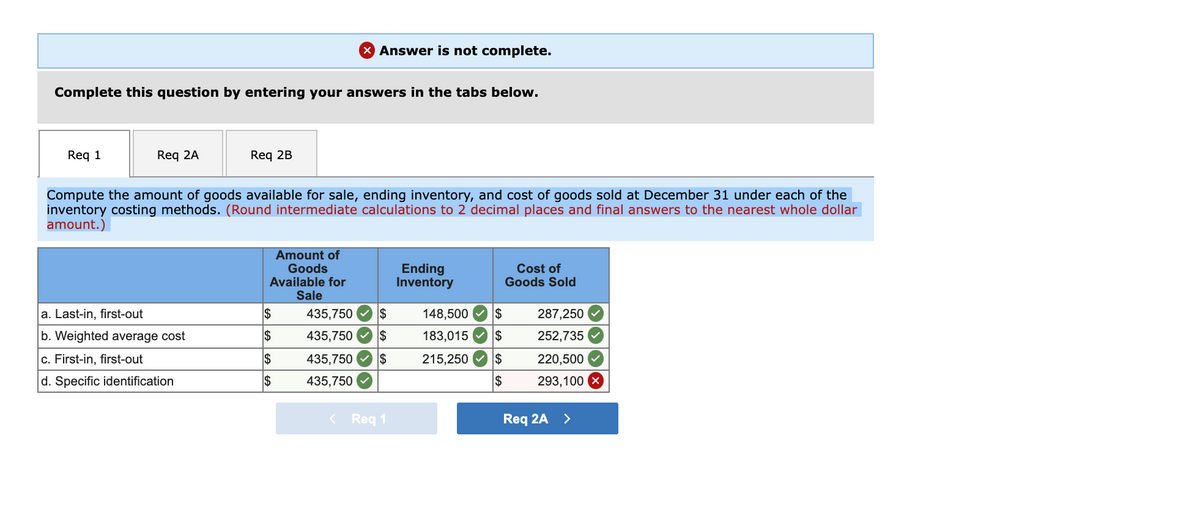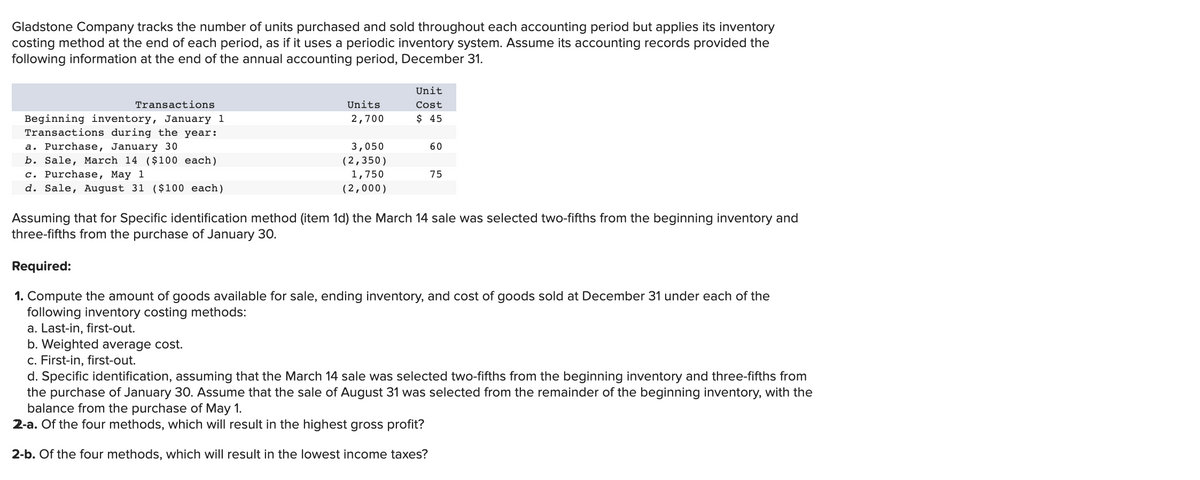Gladstone Company tracks the number of units purchased and sold throughout each accounting period but applies its inventory costing method at the end of each period, as if it uses a periodic inventory system. Assume its accounting records provided the following information at the end of the annual accounting period, December 31. Unit Transactions Units Cost $ 45 Beginning inventory, January 1 Transactions during the year: a. Purchase, January 30 b. Sale, March 14 ($100 each) c. Purchase, May 1 d. Sale, August 31 ($100 each) 2,700 3,050 60 (2,350) 1,750 (2,000) 75 Assuming that for Specific identification method (item 1d) the March 14 sale was selected two-fifths from the beginning inventory and three-fifths from the purchase of January 30. Required: 1. Compute the amount of goods available for sale, ending inventory, and cost of goods sold at December 31 under each of the following inventory costing methods: a. Last-in, first-out. b. Weighted average cost. c. First-in, first-out. d. Specific identification, assuming that the March 14 sale was selected two-fifths from the beginning inventory and three-fifths from the purchase of January 30. Assume that the sale of August 31 was selected from the remainder of the beginning inventory, with the balance from the purchase of May 1. 2-a. Of the four methods, which will result in the highest gross profit? 2-b. Of the four methods, which will result in the lowest income taxes?
Gladstone Company tracks the number of units purchased and sold throughout each accounting period but applies its inventory costing method at the end of each period, as if it uses a periodic inventory system. Assume its accounting records provided the following information at the end of the annual accounting period, December 31. Unit Transactions Units Cost $ 45 Beginning inventory, January 1 Transactions during the year: a. Purchase, January 30 b. Sale, March 14 ($100 each) c. Purchase, May 1 d. Sale, August 31 ($100 each) 2,700 3,050 60 (2,350) 1,750 (2,000) 75 Assuming that for Specific identification method (item 1d) the March 14 sale was selected two-fifths from the beginning inventory and three-fifths from the purchase of January 30. Required: 1. Compute the amount of goods available for sale, ending inventory, and cost of goods sold at December 31 under each of the following inventory costing methods: a. Last-in, first-out. b. Weighted average cost. c. First-in, first-out. d. Specific identification, assuming that the March 14 sale was selected two-fifths from the beginning inventory and three-fifths from the purchase of January 30. Assume that the sale of August 31 was selected from the remainder of the beginning inventory, with the balance from the purchase of May 1. 2-a. Of the four methods, which will result in the highest gross profit? 2-b. Of the four methods, which will result in the lowest income taxes?
Financial Accounting
15th Edition
ISBN:9781337272124
Author:Carl Warren, James M. Reeve, Jonathan Duchac
Publisher:Carl Warren, James M. Reeve, Jonathan Duchac
Chapter7: Inventories
Section: Chapter Questions
Problem 4PB: The beginning inventory for Dunne Co. and data on purchases and sales for a three-month period are...
Related questions
Question
100%

Transcribed Image Text:X Answer is not complete.
Complete this question by entering your answers in the tabs below.
Req 1
Req 2A
Req 2B
Compute the amount of goods available for sale, ending inventory, and cost of goods sold at December 31 under each of the
inventory costing methods. (Round intermediate calculations to 2 decimal places and final answers to the nearest whole dollar
amount.)
Amount of
Goods
Available for
Sale
Ending
tory
Cost of
Goods Sold
a. Last-in, first-out
2$
435,750
$
148,500
2$
287,250
b. Weighted average cost
$
435,750
$
183,015
$
252,735
c. First-in, first-out
$
435,750
$
215,250
$
220,500
d. Specific identification
$
435,750
$
293,100 X
< Req 1
Req 2A >

Transcribed Image Text:Gladstone Company tracks the number of units purchased and sold throughout each accounting period but applies its inventory
costing method at the end of each period, as if it uses a periodic inventory system. Assume its accounting records provided the
following information at the end of the annual accounting period, December 31.
Unit
Transactions
Units
Cost
$ 45
Beginning inventory, January 1
Transactions during the year:
a. Purchase, January 30
b. Sale, March 14 ($100 each)
c. Purchase, May 1
d. Sale, August 31 ($100 each)
2,700
3,050
60
(2,350)
1,750
75
(2,000)
Assuming that for Specific identification method (item 1d) the March 14 sale was selected two-fifths from the beginning inventory and
three-fifths from the purchase of January 30.
Required:
1. Compute the amount of goods available for sale, ending inventory, and cost of goods sold at December 31 under each of the
following inventory costing methods:
a. Last-in, first-out.
b. Weighted average cost.
c. First-in, first-out.
d. Specific identification, assuming that the March 14 sale was selected two-fifths from the beginning inventory and three-fifths from
the purchase of January 30. Assume that the sale of August 31 was selected from the remainder of the beginning inventory, with the
balance from the purchase of May 1.
2-a. Of the four methods, which will result in the highest gross profit?
2-b. Of the four methods, which will result in the lowest income taxes?
Expert Solution
This question has been solved!
Explore an expertly crafted, step-by-step solution for a thorough understanding of key concepts.
This is a popular solution!
Trending now
This is a popular solution!
Step by step
Solved in 2 steps

Recommended textbooks for you

Financial Accounting
Accounting
ISBN:
9781337272124
Author:
Carl Warren, James M. Reeve, Jonathan Duchac
Publisher:
Cengage Learning

College Accounting, Chapters 1-27
Accounting
ISBN:
9781337794756
Author:
HEINTZ, James A.
Publisher:
Cengage Learning,


Financial Accounting
Accounting
ISBN:
9781337272124
Author:
Carl Warren, James M. Reeve, Jonathan Duchac
Publisher:
Cengage Learning

College Accounting, Chapters 1-27
Accounting
ISBN:
9781337794756
Author:
HEINTZ, James A.
Publisher:
Cengage Learning,


Financial And Managerial Accounting
Accounting
ISBN:
9781337902663
Author:
WARREN, Carl S.
Publisher:
Cengage Learning,

Intermediate Accounting: Reporting And Analysis
Accounting
ISBN:
9781337788281
Author:
James M. Wahlen, Jefferson P. Jones, Donald Pagach
Publisher:
Cengage Learning

College Accounting (Book Only): A Career Approach
Accounting
ISBN:
9781337280570
Author:
Scott, Cathy J.
Publisher:
South-Western College Pub